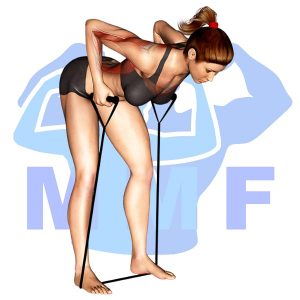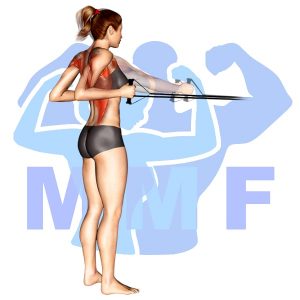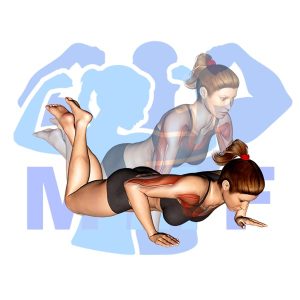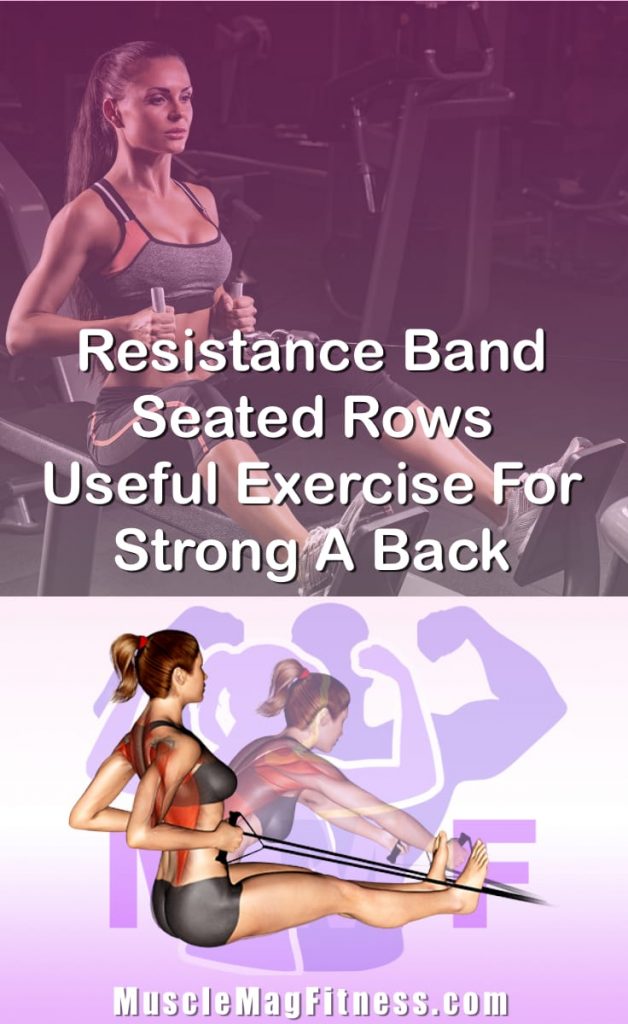Are you struggling to engage your back muscles during your workouts? Do you find yourself avoiding exercises like resistance band seated rows because they are too difficult or uncomfortable? You’re not alone. Many people experience this frustration due to poor form or not fully understanding the movement. It’s understandable, but don’t give up just yet. In this post, I’ll be providing you with step-by-step instructions on how to properly execute resistance band seated rows, so you can effectively target your back muscles and get the most out of your workouts.
Resistance Band Seated Rows Summary
- Primary Muscles: Deltoid – Posterior
- Secondary Muscles: Brachialis, Brachioradialis, Erector Spinae, Infraspinatus, Latissimus Dorsi, Pectoralis Major – Sternal, Rhomboids, Teres Major, Teres Minor, and Trapezius
- Equipment: Resistance Band and Door Anchor
- Mechanics Type: Compound
- Force: Pull
- Utility: Basic

Resistance Band Seated Rows Instructions
- Attach the resistance bands to a secure anchor point close to the base of the floor.
- Sit on the ground feet extended facing towards the anchor point. Bend over at your hips with your arms fully extended towards your feet. When you lean forward and grab the band handles the band should be tight.
- Now perform the seated rows by pulling your arms and bringing your elbows back to your side, and the handles should come close to touching your abs. Additionally, you need to bring your back up straight when you are pulling the bands.
- Pause once you have reached vertical with your upper body and arms are pulled back.
- Next, slowly release your arms back to the starting position and let the bands pull you forward into a lean.
- Repeat these seated rows for 8-12 reps.
Video Tutorial
Resistance Band Seated Rows Muscles
Target (Agonist)
- Deltoid, Posterior
- Erector Spinae
- Infraspinatus
- Latissimus Dorsi
- Rhomboids
- Teres Major
- Teres Minor
- Trapezius
Synergists
- Brachialis
- Brachioradialis
- Pectoralis Major – Sternal
Dynamic Stabilizers
- Biceps Brachii
- Triceps – Long Head
Stabilizers
- Adductor Magnus
- Gluteus Maximus
- Hamstrings
Antagonist Stabilizers
- None

Benefits of Resistance Band Seated Rows
The Resistance Band Seated Rows exercise is a great way to target the posterior deltoid muscle. This exercise helps to increase strength and stability in the shoulder joint, which is particularly important in sports and fitness activities. This exercise also helps to enhance the overall posture of the upper body by strengthening the back muscles, as well as the posterior deltoid muscle. Additionally, by using a resistance band for this exercise, it allows for a greater range of motion, which helps to improve flexibility and mobility. Ultimately, performing Resistance Band Seated Rows regularly in a strength training or fitness routine can help to strengthen and tone the posterior deltoid muscle, resulting in improved posture and better overall fitness.
Tips for Performing Resistance Band Seated Rows
If you want to attain the optimal benefits, adhere to these simple and easy tips. Most Importantly, if you would like to avert injuries, follow these tips.
- Complete The Correct Quantity Of Sets Using Rest. Your target, to begin with, might be to do 3 sets to near fatigue. However, you can raise to 5 sets. If your muscle tissue isn’t tired at the end of 3 – 5, something needs to change. Primarily you can increase the resistance to make each rep tougher. Next, you can cut down on the rest time in between your sets.
- Make Use Of A Mirror To Observe Your Technique. You may well feel a little vain looking in a mirror while you are doing exercises, but you are not admiring yourself, you are insuring your form is strong.
- Slow Your Exercise Down For Better Strength Gains. By Raising the time under tension you are engaging your muscles longer and they will respond by developing toned muscles. You can achieve this without increasing the resistance by slowing down you reps roughly 4 – 6 seconds flexing and pause then 4 – 6 seconds extending.
Benefits and Tips Video
Frequent Mistakes To Avoid
You should avoid these very common mistakes to maintain solid form and muscle growth. At the same time
- Don’t have uneven resistance one each band or you will strengthen both sides with an imbalance.
- Avoid Cheating. In most cases, cheating is utilizing momentum rather than the strain of your agonist (target) muscle tissue. Occasionally, a bit cheating on your final rep can be fine to overload your muscle, but not for more than a couple of reps.
- Stop Yourself From Using Too Little or Too Much Tension. Not enough, and you will not be adequately using your primary muscle, a large amount, and you will probably cheat. Make sure you can do between 8-12 reps with proper form.
Find More Resistance Band Exercises Here
Variations and Complementary Exercises
If you’re looking to mix up your routine and target the same muscle groups as Resistance Band Seated Rows, there are a number of variations, complementary, or alternative exercises that can be added to your workout. Here are some of the best options:
Resistance Band Face Pulls

Resistance Band Face Pulls are an excellent complementary exercise to Resistance Band Seated Rows. This exercise targets the same muscles as the seated rows but in a different way. The face pulls are a great way to build and strengthen the muscles in the upper back and shoulders. By doing the face pulls, you can also improve your posture and core strength. The face pulls also allow you to use the resistance band in a different way, which helps to work different muscles than those targeted by the seated rows. Overall, resistance band face pulls are an excellent alternative or complementary exercise for resistance band seated rows.
Resistance Band Bent Over Shoulder Rows

Resistance Band Bent Over Shoulder Rows is a great complementary or alternative exercise to Resistance Band Seated Rows. This exercise targets the back muscles and requires the user to be in a bent over position while holding the resistance band with both hands. The user then pulls the band towards their chest while maintaining the bent over position. This exercise is a great way to strengthen the back muscles and is a great alternative for those who are unable to perform Seated Rows due to injury or lack of equipment.
Resistance Band Bent Over Rows

Resistance Band Bent Over Rows are a great complementary or alternative exercise for Resistance Band Seated Rows. This exercise targets the same muscle groups in the back, but from a different angle. It also allows you to use heavier bands, which provides more resistance and helps build strength. To perform Resistance Band Bent Over Rows, stand with your feet hip-width apart and hold a resistance band in each hand. Bend your knees slightly and hinge at the hips while keeping your back straight. Pull the bands up towards your chest while keeping your elbows close to your body. Then, slowly lower the bands to complete one rep. This exercise can be done for multiple sets and repetitions for maximum benefit.
Check Out These Top Resistance Band Exercises
Resistance Band Bent Over Rear Lateral Raises

Resistance Band Bent Over Rear Lateral Raises are a complementary or an alternative exercise to Resistance Band Seated Rows. This exercise focuses on the back muscles and helps to improve the range of motion in the shoulders. To perform this exercise, start by standing with your feet hip-width apart and holding the resistance band in both hands, palms facing down. Bend your knees slightly, hinge forward at your hips, and extend your arms straight out to the sides. Keeping your arms straight, pull the band up and back to your sides, squeezing your shoulder blades together at the top of the movement. Slowly lower your arms back to the starting position and repeat. This exercise is great for targeting the posterior deltoids and rhomboids, making it an excellent addition to any upper body workout routine.
Resistance Band Straight Back Seated Rows

Resistance Band Straight Back Seated Rows is an excellent alternative or complementary exercise to Resistance Band Seated Rows. It is a great way to target the same muscles as Resistance Band Seated Rows, but with a slightly different angle and emphasis. This exercise involves sitting upright and holding the band with both hands at shoulder width apart. From there, you will pull your arms back in a rowing motion, squeezing your shoulder blades together at the end of the motion. This exercise is great for strengthening the back and shoulders and can be used as a substitute or addition to Resistance Band Seated Rows.
Resistance Band Standing Rows

Resistance Band Standing Rows is a great complementary or alternative exercise for Resistance Band Seated Rows. This exercise works the same muscle groups, including the back, biceps and shoulders, but in a different way. The standing position allows you to use your body weight as resistance and targets the core muscles more than the seated version. It is important to keep your back straight and core engaged throughout the movement. This exercise can be done with a single band or two bands, depending on your strength level. For an extra challenge, you can try adding a jump at the end of each rep.
Find More Back Exercises Here
Opposing Complementary Exercises
In order to maximize the effectiveness of the Resistance Band Seated Rows, it is important to pair it with exercises that target the opposing muscle groups. This will help to balance out your workout and ensure you are strengthening all the right muscles. Below are a few exercises that work well with the Resistance Band Seated Rows.
Push Up From Knees

Push Up From Knees is a great exercise to complement the Resistance Band Seated Rows. This exercise works the opposing muscle group of the back muscles used in the Resistance Band Seated Rows. It focuses on strengthening the chest and triceps, which will help stabilize the back muscles used in the seated rows. The Push Up From Knees exercise is also beneficial because it can be done at any level of fitness, making it a great exercise for beginners and those looking to add an extra challenge to their workouts.
Lying Cable Fly

The lying cable fly exercise is a great complement to the resistance band seated row. This exercise works the opposite muscle group of the seated row, targeting the chest and shoulder muscles. The lying cable fly is performed on a flat bench with a cable pulley machine. You start by lying on the bench with your arms outstretched and a handle in each hand. You then bring your arms in and together, squeezing your chest muscles. This exercise helps to build strength and stability in the chest muscles, which helps to balance out the strength and stability in the back muscles worked with the resistance band seated row.
Lunge Push Up

The Lunge Push Up is an excellent complement to the Resistance Band Seated Rows exercise. It works the opposing muscle group of the back, namely the chest and triceps. By doing this exercise, you are able to target the muscles of the chest and triceps and ensure that all muscle groups are being worked equally. This exercise is also great for improving overall balance and stability. Additionally, it helps to build strength in the legs and core, which can help with other more complex exercises. Overall, the Lunge Push Up is an excellent complementary exercise to the Resistance Band Seated Rows.
Row Your Way to a Stronger Back with Resistance Bands!
Resistance bands are a great way to add variety to your back workout. The seated row is an exercise that primarily targets the muscles of the upper and middle back, and adding resistance bands to this exercise can make it more challenging and effective. Resistance bands also provide a convenient and cost-effective way to add resistance to your workouts. With a variety of resistance levels available, you can easily adjust the intensity of the exercise to your fitness level. Incorporating resistance band seated rows into your workout routine can help you build a stronger back and improve your posture.
References: Wikipedia | ExRx.net | PubMed.gov | Comprehensive List of Back Resistance Band Exercises

